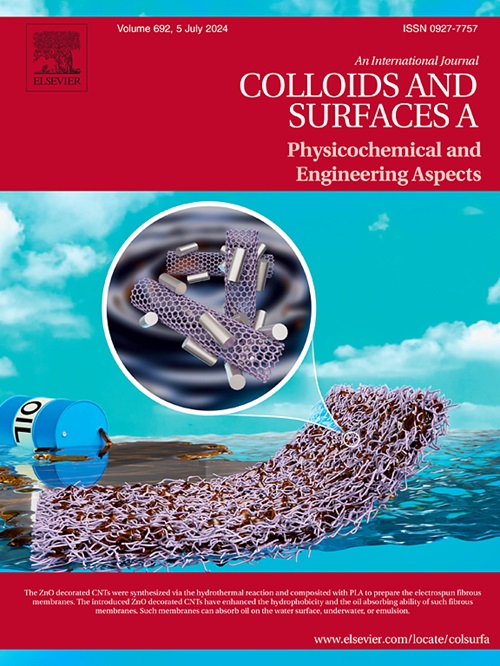Transformation of household waste-watermelon rind into high-performance adsorbents: A low-cost and green strategy for dye removal
IF 4.9
2区 化学
Q2 CHEMISTRY, PHYSICAL
Colloids and Surfaces A: Physicochemical and Engineering Aspects
Pub Date : 2025-06-24
DOI:10.1016/j.colsurfa.2025.137589
引用次数: 0
Abstract
With the escalating severity of water pollution, developing safe and effective pollutant removal strategies has become an urgent priority. Consequently, numerous adsorbents have been synthesized and prepared. However, artificial synthesis inevitably involves the use of toxic components or solvents. In recent years, biomass-based materials have garnered significant attention due to their advantages of being non-toxic, harmless, abundantly available and low-cost. Several biomass-based adsorbents have already been developed and employed for pollutant adsorption. Nevertheless, to endow these biomass materials with high adsorption performance, modification methods such as crosslinking, pore creation, chemical grafting, and carbonization are widely applied. And these processes often involve the introduction of hazardous substances or require high energy consumption. Here, we present a facile and eco-friendly approach to fabricate porous and efficient aerogel adsorbents from biomass waste-watermelon rind, not only avoiding secondary contamination by using entirely green materials, but also circumventing energy-intensive processing procedures. The prepared watermelon rind aerogels demonstrate competitive adsorption performance for dyes and metal ions. Mechanistic analysis reveals that electrostatic interaction, π-π conjugation and hydrogen bonding between polar functional groups on the aerogel surface and target pollutants governs the adsorption process, while its hierarchical porous structure facilitates efficient pollutant transport and immobilization. By transforming household waste into a high-performance adsorbent, this work offers a sustainable and cost-effective solution for water purification, with significant potential for practical environmental applications.
将生活垃圾西瓜皮转化为高性能吸附剂:一种低成本和绿色的染料去除策略
随着水污染的日益严重,制定安全有效的污染物去除策略已成为当务之急。因此,许多吸附剂已被合成和制备。然而,人工合成不可避免地涉及使用有毒成分或溶剂。近年来,生物质材料因其无毒、无害、可获得性高、成本低等优点而受到广泛关注。几种生物质基吸附剂已被开发并用于污染物吸附。然而,为了使这些生物质材料具有较高的吸附性能,人们广泛采用了交联、造孔、化学接枝和碳化等改性方法。这些过程往往涉及有害物质的引入或需要高能耗。在这里,我们提出了一种简单和环保的方法,从生物质废物-西瓜皮中制造多孔和高效的气凝胶吸附剂,不仅通过使用完全绿色的材料避免了二次污染,而且还避免了能源密集型的加工过程。所制备的西瓜皮气凝胶对染料和金属离子具有竞争性吸附性能。机理分析表明,气凝胶表面极性官能团与目标污染物之间的静电相互作用、π-π共轭和氢键控制了吸附过程,而其层次化的多孔结构有利于污染物的高效运输和固定化。通过将生活垃圾转化为高性能吸附剂,这项工作为水净化提供了一种可持续的、具有成本效益的解决方案,具有实际环境应用的巨大潜力。
本文章由计算机程序翻译,如有差异,请以英文原文为准。
求助全文
约1分钟内获得全文
求助全文
来源期刊
CiteScore
8.70
自引率
9.60%
发文量
2421
审稿时长
56 days
期刊介绍:
Colloids and Surfaces A: Physicochemical and Engineering Aspects is an international journal devoted to the science underlying applications of colloids and interfacial phenomena.
The journal aims at publishing high quality research papers featuring new materials or new insights into the role of colloid and interface science in (for example) food, energy, minerals processing, pharmaceuticals or the environment.

 求助内容:
求助内容: 应助结果提醒方式:
应助结果提醒方式:


